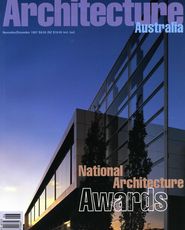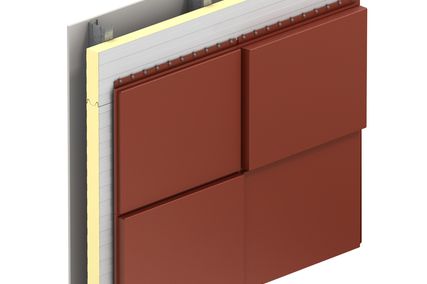Interior Design: In or Out?I would like to thank the reviewer of the Interior Design: In or Out? forum (AA July/August 97) for the recognition of the forum’s success. It would appear, however, that the reviewer may have “attended” a forum which significantly differed from the one which I attended. I found the tone of the review to be patronising and the intent ill-informed. This raises questions as to why the reviewer considered it necessary to take such a stance. Firstly, I would like to note that Marina Lommerse did not present a paper and a significant omission was the contribution on the Saturday by Lindsay Clare. Davina Jackson’s paper noted that historians would look back with interest at the issues that interior design professionals were discussing in 1997. Discussions and the formal papers raised issues such as the detrimental effects of our political system on education, the effect of technological changes on delivery systems and communication practices, the current mismatch and future potential of research assisting practice, perceptions of interior design as transportable objects vs interior design as experience, the influence of these perceptions upon practice and education and the shift from competition to co-operation between professional domains. Although sceptics always arise on the eve of change, it was evident that those with an interest and commitment to interior design, whether from design, architecture or other related disciplines, had moved from a potentially divisive position of “who is or should be an interior designer” to fostering the development of interior design as a profession addressing the new millennium. The ability to self-evaluate and reflect upon one’s professional practice could be perceived as ‘navel gazing’—as implied by the reviewer—but could also be seen as characterisation of a “reflective practitioner” (as described by Donald Schon) and therefore a necessary responsibility of any committed professional within any discipline. —From Dianne Smith, In or Out forum convenor, QUT, Brisbane Negative ThemesI write in response to Professor John Andrews’ review of the Queensland University of Technology’s national interior design conference In/Out (Radar Review, AA September/October 97). Professor Andrews is obviously well versed in the current culture of interior design and therefore one would expect to witness the pride shining from his eyes at an event that captured nationally acclaimed Australian designers (including Queensland architect Lindsay Clare), international keynote speakers, profound creativity, intellectual stimuli, dialogue and debate … not so. I found the tone of Professor Andrews’ review somewhat belittling to the many successes of the conference, let alone to the status of interior design in Australia. I agree: too much time was spent on dissecting ‘what is interior design?’; however, this provided a base for investigation and many more issues surfaced from this theme. Yes, soul-searching is usually part of such workshops because unless some emotion is felt, then there will be no motivation for progression. After all, it is the first national forum to provide the opportunity for interior designers to gather together informally to share their experiences. The comment “a profession … not quite a profession, but really wants to be one”. What is this? We have moved past this level long ago and are not put off by it. Also, the quotes “trying to analyse”, “memorable talks by …” and “ultimately the conference could be described as a success” reek with cynicism. I must say that such a view hardly speaks of advocacy, recognition and respect for interior design to an audience of our architect colleagues. Perhaps these negative themes highlight why the only way we must go is to seek the registration of interior design on its own merits and become a truly recognised profession. Improving the level of education of interior designers is a way to this. The Design Institute of Australia, in collaboration with the leaders in education, are striving towards this in many ways. I would like to congratulate QUT Interior Design School’s Dianne Smith and Jill Franz for initiating a new stimulus for the interior design profession in Queensland. The results have been evident. We have had a surge of invigorated designers now showing interest in their profession and subsequent funding from the Arts Office of Queensland for a new initiative, Design Week, to be held next year. I am proud to have been associated with a forum of such calibre. Perhaps the grey skies in Melbourne have clouded Professor Andrews’ vision but I assure you we see very clearly from where we are: a bright future for our career! —From Revy Bryce-Browning, Queensland president, Design Institute of Australia and partner Minale Tattersfield Bryce, Brisbane RAIA: Federal, National or Hybrid?The recent High Court decision that the States may not legally collect ‘excise’ on tobacco, alcohol and petrol again raises the federal versus national issue of government and prompts these reflections on that issue, as it applies to the RAIA. The RAIA could have been formed as a federal body 10 years before Australia became a federation in 1901. Though a (national) constitution was adopted in 1929, it operated as a federation, in deference to the ingrained perception of ‘states’ rights’. Fifty years later, it decided that to operate on a national basis would overcome internecine wrangling between the various power bases and between chapters and ‘Canberra’. Ultimate power resides with those who hold the purse strings and now that ‘Canberra’ will raise the lion’s share of government-imposed taxes, it will be interesting to see whether federal policies reflect a more national and international perspective and whether John/Jane Citizen perceive further disenfranchisement The next logical step of course is to reconsider the questionable cost-benefit of eight state and territory governments. (The ultimate in economic rationalism?) The RAIA recently restructured itself as a kind of hybrid federal/national organisation and with the benefit of having the Chapter presidents ex officio on national council and some members elected Australia-wide, it is possible that their policies will reflect the broader view, whilst retaining membership enfranchisement, the best of both worlds. This may even prove to be a model that our federal government could well emulate, though changing the 1901 constitution could prove more difficult. —From Donald Bailey, Sydney FixIn our coverage of Kerry Hill’s Genesis shophouse project in Singapore (AA September/October 97), we stated that the facade louvres were a rainforest timber but balau is plantation-grown—Ed. | Internationals In TownThe recent contracting of well-known northern hemisphere architects to design major Sydney landmarks is good news, not bad, for Australian architecture. The works of Piano, Foster, Seijima, et al, will raise both our standards and our international standing. —From Simon Hamilton, Sydney Translating ObscuritiesI suggest the following translations for portions of AA July/August 97.
There is more of the same. Why do you pump out such blithering bullshit? This magazine will join all my other AAs in the bin. I have never read one in its entirety. Architecture is a four-dimensional thing (time and space). Don’t try to describe the indescribable. Use words for what they are good for—communicating ideas, giving information. —From Roger M. Dalton, Townsville, Qld and Port Moresby, PNG. More Wholistic Reporting, PleaseI refer to the July/August 1997 edition of AA. Reading this magazine is hardly an education; the methods and presentation of critiques indicate a ‘gingerbread house’ level of architectural knowledge. The Zumbotel/Staff showroom (pp 12-13) is discussed in a most ‘unwholistic’ manner; no questions are raised about the suitability of the novel shape of the auditorium for acoustics. I would suggest that the sound is badly focused to many spots within (as with the Royal Albert Hall); obviously an acoustics expert has worked to ameliorate this design, which is also assisted by electronic amplification. Regarding the ‘Arabian Rights’ Ultimo Community Centre (pp 60- 65), this comparative critique is neither convincing nor believable without supporting comparative illustrations of the Fez house. I refer AA to the article ‘The Petronas Twin Towers (Islamic Themes)’ by Henry Petroski on pp 322-326 of American Scientist July/August 1996, which shows how a simple diagram can give credibility to far-fetched analogical fantasy. Regarding Ultimo, there can be little doubt that the designers’ influences were stereotypically Jewish, with the protruding lumpy bits on the facade being highly reminiscent of Zvi Hecker’s Ramot housing (Jerusalem, 1979). A most appalling aspect of AA’s presentation is that little space is given for the building designer’s personal commentary on concepts and their execution; the critics resort to speculation and suggestion. When analogies are used, the arguments must be supported by illustrations. The article ‘Warp‘ (pp 34-39) might then be intelligible, revealing the true natures of the intellects of those concerned. I would appreciate it if AA would publish technical research in imitation of the Architects Journal, so as to give scientific balance to a generally fine aesthetic presentation. —From Michael John Katalinic, Albury, NSW We BragArchitecture Australia has won another graphic design honour: this time for Best Use of Photography in our category at the Australian Society of Magazine Editors Awards recently presented in Sydney. Other shortlisted titles in this category were the Australian Financial Review Magazine , a glossy newspaper supplement, and Panorama, Ansett’s inflight journal. In accepting this award at a dinner of 400 magazine notables, we thanked our designers, Carl Martin and Michelina Fortuna, and the talented Australian and international photographers who regularly donate first-class photographs on a credit-only basis. We are particularly indebted to John Gollings of Melbourne, who, in one recent example of generosity, commissioned a helicopter at his studio’s expense to score essential aerial views of Wood Marsh’s ensemble at Deakin’s Bundoora campus. (To unveil a behind-the-scenes creative debate, Gollings has since expressed grave doubts about our circular cropping of some of these photographs—a graphic strategy which we intended to emphasise the the radial plan of the five-building complex and circular central stair.) Other especially supportive photographers include Reiner Blunck, Patrick Bingham-Hall, Kate Gollings and Simon Kenny, and more regular contributors are listed on our contents page. Out in cyberspace, Architecture Media Australia’s web site— http://www.archmedia.com—has won a five star rating in a global survey of Internet pages about architecture, recently published in the Australian magazine internet.au. Their reviewer advised that “this stunning set of pages is the home of three magazines, Architecture Australia , Houses and Architectural Product News. … The features in Architecture Australia are fantastic: the layout is great, the photographs are gorgeous and you’ve got to love headlines about alien landings in suburban paddocks. … Verdict: making architecture fascinating.” As an aside, internet.au’s scores for other web sites included five stars for Leonardo da Vinci, four stars for Palladio’s Villas, Walter Arnold’s stone gargoyles, Australian virtual architect Gary Venter, the RAIA, MIT Press and the Landscape Architecture Virtual Library of Toronto. Three stars went to Abitare magazine in Italy, Rome’s Sistine Chapel and Sydney University’s architecture faculty. Keywords into an online search engine should find the addresses—Ed. We welcome your concise views on issues of interest to architects. Please provide fax and phone numbers-we may need to edit. Only letters to the editor, not copies of letters to others, will be published. The RAIA’s chief executive officer has right of reply to criticism of the Institute. Address to 4 Princes Street, Port Melbourne 3207. Fax (03) 9646 4918. Or email |
Weldon















